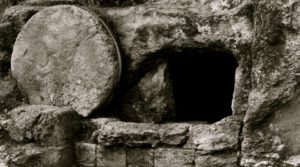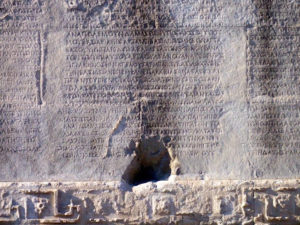The Bewilderment of Mary Magdalene
Women of Galilee ran from the empty tomb terrified by their angelic encounter – Gospel authors collectively identified them as Mary Magdalene, Joanna, Mary the mother of James, Salome and “the other women.” Breathlessly arriving at the location of two of the mourning disciples, Peter and John, Mary Magdalene blurted out:[1]
JN 20:2 “They have taken the Lord from the tomb, and we don’t know where they have put him!” (NIV, NET)
A credible eyewitness statement, as opposed to an investigative report, is expected to begin at the point when the witness becomes personally involved in the sequence of events. The author of the Gospel of John’s personal involvement that Sunday morning began when the women burst into the room with their frantic news.
John and Peter were confused by Mary Magdalene’s excited statement. Faced with the group of excited women saying the body of Jesus had been taken was… dumbfounding.
LK 24:11 “But these words appeared to them as nonsense, and they would not believe them.”(NASB)[2]
Secured in a tomb behind a large stone held the mutilated, decomposing body of Jesus, tightly bound in linens with 75 pounds of spices – who would want it? Romans certainly didn’t want a body from a crucifixion which they typically discarded unburied, according to Josephus.[3]
Undoubtedly Jewish leadership didn’t want to lend any credence to a Resurrection especially since Jesus predicted he would rise from the dead after 3 days. Such a claim would be even worse, they told Pilate.
Maybe John and Peter knew of the armed Roman-Jewish koustodia guarding the sealed tomb, too. Additionally, a body snatching would have broken several Jewish Laws with at least a 7-day defilement consequence and no legitimate Jew wanted this.[4]
Mary’s blurted statement uses the Greek word airo meaning “to lift up,” translated into English as “have taken” in the context of the body had been taken by someone.[5] It conflicts with the actual angelic message in the accounts of Matthew, Mark and Luke who used the Greek word egeiro translated into English as “has been raised,” “has risen” or “is risen”: [6]
MT 28:6 “He is not here; for he has been raised [egeiro]”(NET, NLT, NRSV)
MK 16:6 “He has risen [egeiro]; He is not here.”(NASB, NIV)
LK 24:6 “He is not here, but is risen! [egeiro]”(NKJV)
Mary Magdalene did not relay the same message the angels had given to the women! Compounding the Disciples’ confusion, use of the plural pronoun “we” indicates she was not alone in this thinking – the other women with her did not dispute Mary’s assessment when she said “they have taken” his body.
How did the message get twisted? Mary Magdalene’s exclamation indicates her state of mind trying to reconcile what she had just experienced at the tomb with what she knew to be true – Jesus was dead, his body was missing and she didn’t know where it was.
Two Greek words, egeiro and airo, have similar meanings; the first being the movement action of a person and the second being the movement action of an inanimate object. Distinctions can be seen when both words were actually used together in a sentence by Jesus after he had performed one of his miracles. His words were reported by three different authors:
MT 9:6 “…He said to the paralytic, “Arise [egeiro], take up [airo] your bed, and go to your house.””(NKJV)
MK 2:11 “”I say to you, arise [egeiro], take up [airo] your bed, and go to your house.””(NKJV)
JN 5:8 “Jesus said to him, “Rise [egeiro], take up [airo] your bed and walk.””(NKJV)
Miraculously healed, the paralytic – the person – was commanded to rise [egeiro] on his own power without assistance and take up [airo] his bed, an inanimate object. Applying these word usage definitions to the two scenarios brings clarity to the contexts.
At the tomb, the angels’ message said Jesus had risen [egeiro] under his own power without any assistance – not possible for a dead man to do. In Mary Magdalene’s exclamation, she thought the inanimate body of Jesus had been “take[n] up” [airo] in the context of being “picked up” by a person or persons unknown and taken away.

Mentally processing their thoughts, suddenly a light bulb moment struck Peter and John at about the same time.[7] They raced to the tomb, John arriving first but paused while Peter charged straight inside.[8]
Still distraught over the death of Jesus and his missing body, Mary Magdalene followed John and Peter to the empty tomb.[9] Containing only the burial linens, the two Disciples marveled at what they had seen, then went back home leaving Mary behind weeping and trying to make sense of what had happened.
Looking back inside the empty tomb, Mary Magdalene once again saw two angels who were seated on each end of the place where the body of Jesus had lain. She had witnessed this earlier as it was prepared with burial spices by Joseph of Arimathea and Nicodemus.[10]
In her second angelic encounter that morning, this time Mary spoke to the angels who seemed perplexed as to why she was distraught asking her, “Woman, why are you weeping?”[11] She reiterated to the angels her missing body observation by repeating what she had told to Peter and John still using the word airo:
JN 20:13 “They have taken [airo] my Lord away, and I do not know where they have put him!”(NET, NIV)
Use of “they” rather than “you” in both of Mary’s statement suggests she believed these other persons who took away the body of Jesus were not present. By using the singular personal pronoun “I,” she is now speaking only for herself, not the other women.
Another voice asked Mary why she was crying. Maybe, she thought, he might be the person responsible for carrying away (bastazo – to lift up) the body of Jesus. Believing this new voice to be the gardener of the tombs, her demeanor and response intensified directly asking:[12]
JN 20:15 “”Sir, if You have carried (bastazo) Him away, tell me where You have laid Him, and I will take (airo) Him away.””(NJKV))[13]
“Mary!” – he called her by name. Not expecting this stranger to know her name and saying it in a familiar way that she immediately recognized, it snapped her to attention.
Clearly seeing Jesus, Mary cried out, “Rabboni!” meaning “my master, my teacher.”[14] Her excited utterance indicates a before and after death recognition of Jesus of Nazareth.
Overwhelmed with joy, Mary wanted to hug Jesus, but he told her to wait because he had not yet ascended “to My Father.”[15] Did Mary believe she was speaking to the same personage of Jesus whom she had known before he was crucified and buried?
Updated May 27, 2024.
Creative Commons Attribution-NonCommercial-NoDerivatives 4.0 International License.
REFERENCES:
NET = NET Bible translation; NASB = New American Standard Version; NIV = New International Version; NKJV = New King James Version translation; NLT = New Living Translation; NRSV = New Revised Standard Version.
[1] CR Matthew 28; Mark 16; Luke 24.
[2] CR Mark 16.
[3] Josephus, Flavius. Wars of the Jews. Trans. and commentary. William Whitson. The Complete Works of Josephus. 1850. Book IV, Chapter V.2. <http://books.google.com/books?id=e0dAAAAAMAAJ&printsec=frontcover&source=gbs_ge_summary_r&cad=0#v=onepage&q&f=false>
[4] Exodus 23, 31; Leviticus 23, Numbers 19. Soncino Babylonian Talmud. “Shabbath.” The Babylonian Talmud. Trans. Rodkinson. Book 1, Sabbath, Chapter I; Book 2, Tract Erubin; Book 3, Tract Pesachim, Book 3, Chapter IV. “Shabbat” Jewish Encyclopedia. 2011. <http://jewishencyclopedia.com> “Festivals.” Jewish Encyclopedia.
[5] Net.bible.org. Greek text. Strong. “airo” <142The New Strong’s Exhaustive Concordance of the Bible. <http://classic.net.bible.org/strong.php?id=142>
[6] Net.bible.org. Matthew 28:11. Greek text. “egeiro” <1453>” <http://classic.net.bible.org/strong.php?id=1453>
[7] Mark 9; Luke 18.
[8] Luke 24; John 20.
[9] John 20. CR Luke 24. “Centuries later, archaeologists opened the tomb of Jesus.” News24hours. photo. 2016. <https://news24hours.in/2016/10/31/centuries-later-archaeologists-opened-the-tomb-of-jesus-christ>
[10] Matthew 27; Mark 15; John 3, 7, 19.
[11] John 20. NET.
[12] Net.bible.org. Greek text. “bastazo <941>.” <http://classic.net.bible.org/strong.php?id=941>
[13] NKJV.
[14] John 20:16. Net.bible.org. Greek text. NASB, NIV. “rhabboni <4462>” and “didaskalos <1320>. CR Matthew 23:8.
[15] John 20. CR Matthew 28.

